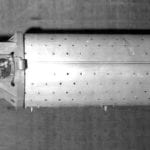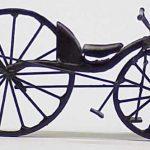 Mysteries
Mysteries  Mysteries
Mysteries  History
History 10 Surprising Stories About the Texas Rangers
 Humans
Humans 10 Philosophers Who Were Driven Mad by Their Own Theories
 Miscellaneous
Miscellaneous 10 Video-Game-Worthy Weapons and Armors from History
 Weird Stuff
Weird Stuff 10 Psychics Who Accurately Predicted Wartime Events
 The Arts
The Arts 10 Pieces of Art Inspired by a Broken Heart
 Health
Health 10 Science Fiction-Sounding New Medical Treatments
 History
History 10 Surprising Facts About the Father of Submarine Warfare
 Space
Space Ten Astonishing New Insights into Alien Worlds
 Weird Stuff
Weird Stuff 10 Bizarre Summer Solstice Rituals Still Practiced Today
 Mysteries
Mysteries Top 10 Haunting Facts About the Ghost Ship MV Alta
 History
History 10 Surprising Stories About the Texas Rangers
 Humans
Humans 10 Philosophers Who Were Driven Mad by Their Own Theories
Who's Behind Listverse?

Jamie Frater
Head Editor
Jamie founded Listverse due to an insatiable desire to share fascinating, obscure, and bizarre facts. He has been a guest speaker on numerous national radio and television stations and is a five time published author.
More About Us Miscellaneous
Miscellaneous 10 Video-Game-Worthy Weapons and Armors from History
 Weird Stuff
Weird Stuff 10 Psychics Who Accurately Predicted Wartime Events
 The Arts
The Arts 10 Pieces of Art Inspired by a Broken Heart
 Health
Health 10 Science Fiction-Sounding New Medical Treatments
 History
History 10 Surprising Facts About the Father of Submarine Warfare
 Space
Space Ten Astonishing New Insights into Alien Worlds
 Weird Stuff
Weird Stuff 10 Bizarre Summer Solstice Rituals Still Practiced Today
Ten Offbeat “Hit-or-Miss” Inventions
In a world where the only certainty is change, new waves of inspired inventors are always on the horizon. As any creator would know, the road to innovation is often paved with obstacles and question marks. Many products have come and gone in a fleeting moment in time—from the comical to the bizarre to those belonging to an era.
Here is a look at ten offbeat “hit or miss” gadgets and contraptions from different eras:
Related: 10 Victorian Inventions We Just Can’t Do Without
10 Full-Body Umbrella
The full-body umbrella began appearing randomly on streets in China and Japan in 2012. While designed to guarantee total protection from rain and wind from all angles, unfortunate drawbacks became obvious in terms of practicality and space management.
Zeng Yi of China filed a patent in 2012 for an umbrella with a body-length plastic sheet hanging from the brim. The clear sheet encircles the user and looks like a round vintage shower curtain. One version is manufactured by the Shenzhen Blueprint Umbrella Company in China.
A more high-tech model was spotted in Tokyo in 2008. The design involved joining five see-through umbrellas with panels to form a plastic dome (kind of resembling a transparent igloo). While there are several images of this version on the internet, the mysterious maker could not be traced (according to Google, at least).
Seems like it would be an awkward moment visiting a street stall or waiting for public transport engulfed by a full-body umbrella. Not to mention getting around town in a get-up that looks like something from outer space or a biohazard protection tent.[1]
9 Spinning Ice Cream Cone
Granted, this would be a fun novelty for kids, but humans were given dexterous fingers and opposable thumbs to twist and turn things around after all. However, American giftware company, Hammacher Schlemmer, assured shoppers that this motorized cone would prevent any “tiresome head turning or wrist twisting.” It would also save “lethargic lickers” from the “tedious task of moving one’s mouth.” The product came in bright colors and also featured a built-in drip basin.
The Lazy Licker’s Spinning Ice Cream Cone is no longer available, but reviews on Hammacher Schlemmer’s website date back to 2017 and 2018. The product did seem to hold genuine appeal for the young ones due to the quirk factor.[2]
8 Vending Machine for Tanning
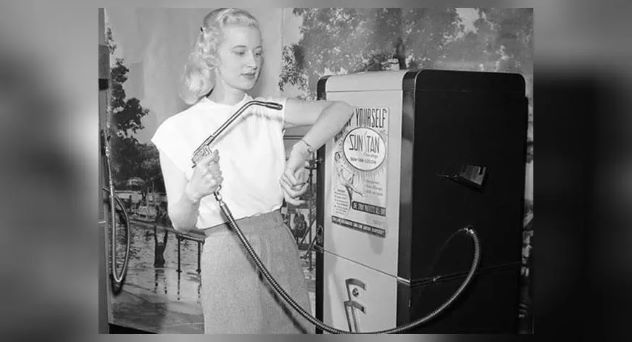
The suntan vending machine was developed by Star Manufacturing Company in the United States in 1949. At first glance, it could have been mistaken for a fuel pump. In the 1950s (when the word suntan became a buzzword linked to health and beauty), the machines began appearing near venues such as pools, beaches, and tennis courts.
For an on-the-go tan, it cost 10 cents for a 30-second spray. As you may imagine, some weirdly streaky and blotchy-looking people could have then turned up to their beach trip or tennis match. Not the case, however, for Betty Dutter—a model who expertly demonstrated how to use the device at the Annual Vending Machine Convention in Chicago in 1949.[3]
7 Pluto Lamps
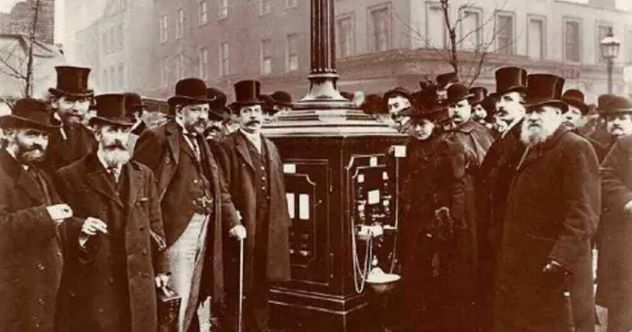
As the Victorian era was coming to a close, Pluto Lamps began to crop up around London. The combined street lamps and vintage-style vending machines became quite the attraction for the city folk of the time. Created by a company founded in 1896 by HM Robinson (also known as the Refreshment Lamp Syndicate or Hot Water Supply Syndicate), the first Pluto Lamp was opened in Leicester Square in 1898. A gas lamp was mounted on a Denayrouze burner that quickly drew quarts of water. The machine could dispense a gallon of hot water or a halfpenny’s worth of tea, coffee, cocoa, milk, sugar, or beef tea essence.
Unfortunately, Pluto Lamps did not make it to the new century and disappeared as swiftly as they had arrived. In April 1899,
6 Anti-Bandit Bag
In the days before online banking and secure armored transport, cashiers transporting money could be an easy target for thieves. Enter the anti-bandit bag of 1959. The bag was promoted by the British media after a wave of robberies in the 1950s. While the inventor is unpublished, a demonstration reel courtesy of British Pathe sets the scene.
With a vibe akin to a Batman episode, we discover how this new technology will thwart those pesky bandits. Hidden inside the bag is a container attached to a wire. When the bag is snatched, the current activates and sends billows of red smoke into the air. The red dye also stains the bandit’s clothes and the money, so even if they get away, the jig is up. Unfortunately, the invention never reached the stage of being purchased—likely, in part, because a prominent wire attached to the user’s wrist was ironically obvious. As a side note, the actors playing the criminals in the clip were actually British cricket players, Godfrey Evans and Bill Edrich.
Other versions of anti-theft bags followed in the early 1960s. The Amazing Anti-Theft Security Case featured in a 1961 newsreel for British Pathe. When the case is grabbed, three metal poles burst from the bag as a siren wails, and the bandit’s hand is trapped in the handle. Hopefully, no bystanders would be there at the time to be whacked by the giant poles.
Another model of an anti-bandit bag was patented by the American inventor, John H. T. Rinfret, in 1963. In his design, a chain was pulled to eject the base of the case. With contents scattered all over the ground, the thief’s plan would be foiled. Unless, of course, a swift-moving bandit snatched an item from the ground and scurried away.[5]
5 Cat-Mew Machine
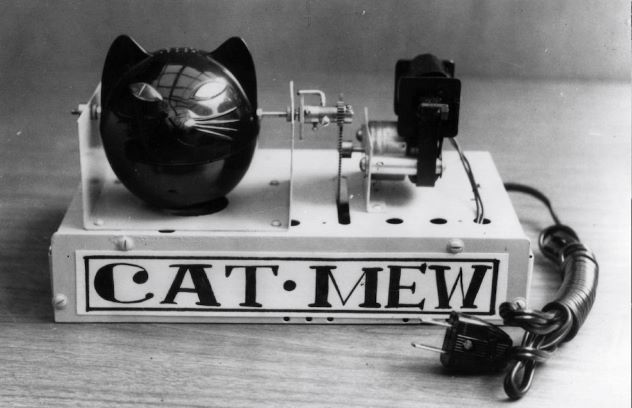
Since ancient times, humans have devised strategies for keeping rodents at bay. However, none quite like the cCat-Mew Machine. As reported by the New York Dispatch in September 1963, “a new device patented by a Japanese company will scare the living daylights out of rats and mice.”
With a black plastic cat head mounted to a base, the machine is plugged into a regular power circuit. In order to ward off lurking creatures, the machine made several cat meow noises per minute as the cat’s eyes lit up. Imagine how you would feel trying to sleep if the Cat-Mew Machine was anywhere near your bedroom? Likely, it’s as though the most aggravating cat in the world was on an all-night mission to drive you up the wall.[6]
4 Baby Cage
This dubious invention would not make it past the planning stage today. However, some misguided parents of past generations thought they were doing the right thing by purchasing or making a dangling baby cage. In an era when physicians had promoted the importance of fresh air for the health and immunity of babies, some city dwellers took it a giant step further. Without access to backyards, they sometimes placed babies and toddlers outside their apartment window in a mounted cage. The first commercial patent for a baby cage was filed by Emma Read of Washington in 1922. But it was in 1930s Britain that the idea gained momentum.
A British Pathe newsreel from 1953 paints the baby cage in a very pure and harmless manner. A loving mother bundles up her baby in a West London apartment before settling her into the cage. The suspended enclosure is described as a “stand-in garden,” “place in the sun,” and “life in a penthouse” for little Sally and her toddler brother. Another clip of the same vintage promotes the cage as a safety measure, as now Mom can continue knitting without worrying that her toddler will fall out the window. Luckily there are no known reports of baby cage tragedies, and society woke up to the potential dangers and phased them out.[7]
3 Selfie Toaster
The Selfie Toaster was released in 2014 and was the brainchild of American Galen Dively of the Vermont Novelty Toaster Corporation. The unique concept involved copying images from photos (mostly of faces) directly to toast. Consumers would send their image to a “Toast Artist” at a website named Burnt Impressions. From there, the company would create a custom template to fit each toaster. While Burnt Impressions has now shut up shop, the maker still receives positive feedback about what a funny gift it was to give to family and friends.
According to reviewers, the Selfie Toaster had some unfortunate drawbacks in the toasting stakes. A reviewer for The Guardian, Australia referred to the device as a “wildly uneven toast.” He spoke of the darker replications in photos being charred and burned while other areas were undercooked. So not the most appealing breakfast option (or choice if you found buttering your face in the morning and eating it a little weird). However, for the novelty value and a laugh, it seems many households and businesses got a kick out of the Selfie Toaster.[8]
2 Keyboard Jeans
In 2008, Erik De Nijs and Tim Smit of the Dutch design company Nieuwe Heren created a pair of jeans like no other. They introduced the keyboard jeans (named “Beauty and the Geek”), complete with a flexible silicone keyboard spanning each upper leg. Speakers were integrated into the design, along with a mouse attached to an elastic wire and kept in the back pocket. The hard-wearing pants were designed to provide alternate keyboard postures and prevent Repetitive Strain Injury. At a time when smartphone and tablet connectivity was being developed, the device relied on wireless hook-up to a computer or laptop.
While scoring points for their one-of-a-kind quality, the lightweight jeans raised a few question marks. Apart from some user postures looking a little slumpy, would anyone actually be game enough to hit the streets in them? Also, what if the wearer wants to sit down when not connected and plonks straight down on the mouse? Is washing any part of the jeans an option?
Perhaps the answers were best summed up in a 2012 interview with De Nijs for WebPro News. He advised that while he would like to see the jeans make it to retail, “the whole product is too complex, and we don’t have enough money right now to get it ready for the market.” Maybe that’s for the best.[9]
1 Radio Hat
The Man from Mars Radio Hat of 1949 was advertised as “a dream-come-true radio hat.” The pith helmet with a built-in radio made quite a splash for a fleeting moment—and looking like a martian was beside the point. The hat was created by Victor Hoeflich, the founder of the novelty manufacturing company American Merri-Lei Corporation of Brooklyn, New York.
The invention relied on radio valve technology which had progressed during World War II. Two distinct antenna-looking tubes sat at the front of the hat, with a tuner in between. The device also had a bulky loop aerial at the rear that looked similar to a watering can handle. While designed to cover broadcasts within a 20-mile radius, an advert assured that the hat was “absolutely mobile… no extra aerial needed.” The circuitry inside the hat’s lining was connected to a radio receiver earpiece, with a cord attached to a battery charger in the user’s pocket.
While battery-operated portable radios were on the market then, the pocket transistor was still five years away from commercial use. Therefore, Hoeflich aimed to market a product that prmised ease of movement while listening to the radio. In his marketing campaign of 1949, teenagers modeled the radio hats, which came in the colors of Lipstick Red, Tangerine, Flamingo, Canary Yellow, Chartreuse, Blush Pink, Rose Pink, and Tan.
After featuring in several newspapers and magazines of the time, the Man from Mars Radio Hat retailed across the United States for $7.95. However, after a moment in the sun, the hat was pulled from production in the early 1950s. Users reported that frequencies sometimes dropped, even after a simple movement like a turn of the head. Others reported technical problems when trying to tune stations, such as an irritating squealing noise. In addition, new technology was evolving on the horizon of the new decade. In any case, the radio hat was an ironic contrast to the (so-called) broadband outage crises of today’s world.[10]


